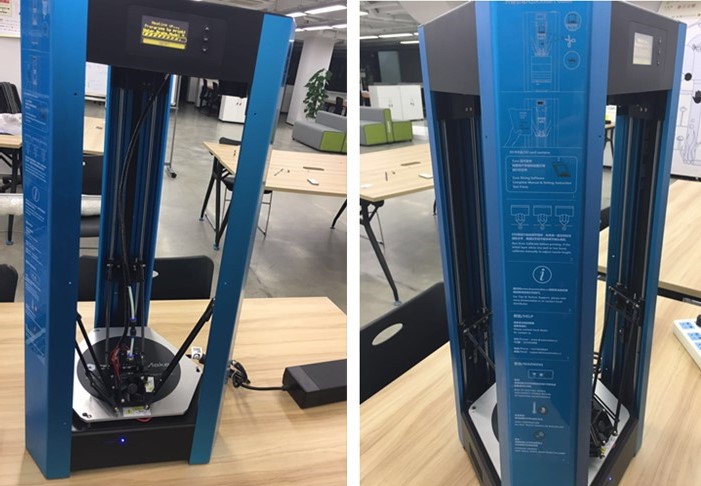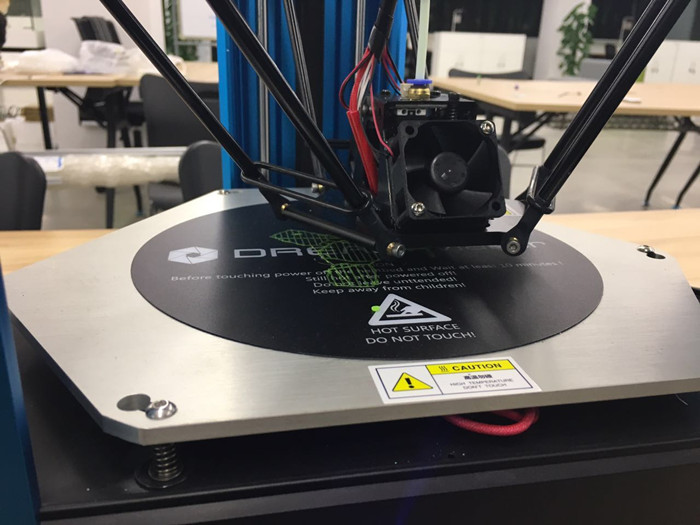OverLord Plus: Is the desktop 3D printer available for Xiaobai?
Since Chuck Hull invented the first 3D printer, this cool device has been around for more than 30 years. However, although there are a large variety of 3D printers on the market, they are often criticized for their size. To this end, the Shanghai DreamMaker team created a desktop 3D printer OverLord Plus. In their own words, this is a 3D printing device that can really be placed on your computer desk with your computer, scanner, and printer.

The reason for the Plus version is that as early as 2014, OverLord's generation of machines has been available. This Plus version will be open to all creators and fans in addition to the machine upgrades. To promote the growth of 3D printers and the open source community. Let's take a look at how it works and how it works.
OverLord Plus printer parameters:
Body weight and volume: 12kg, 370 × 320 × 725mm
Single nozzle printhead: nozzle diameter 0.4 mm
Monofilament diameter: 1.75 mm
Maximum print size: 170mm (diameter) x260mm (height) cylinder
Fine mode 100 micron / standard mode 200 micron
Printing speed: 100 mm/s
Connection method: SD card or USB cable
In addition to the above parameters, the printer's printed materials support ABS resin and PLA (biodegradable plastic polylactic acid), which are black, red, blue, orange, purple, yellow, cyan, eucalyptus, green, white, pink, and grass green. A variety of color materials are available.

Accessories and appearance
Currently, OverLord Plus has two colors, blue and black. The most special appearance is its triangular structure. It is understood that the design incorporates Chinese elements and is based on the ancient design of the pavilion. From top to bottom, the whole machine is the power switch, the operation interface (liquid crystal screen and several buttons) and the U disk interface commonly used in office equipment. Compared to traditional square 3D printers, the OverLord Plus resolution is 100 microns, making it more efficient than traditional 3D printers. In addition, since this structure does not require a large number of parts, its price is relatively close to the public.
It is understood that the traditional 3D printer is mainly driven by high-priced belts, the belt replacement is not easy and the size of the product is limited by the length of the belt. OverLord Plus uses three stepper motors to scroll the fishing line that connects the printhead module, which is easier to adjust and replace. If you need to print larger products in the future, you can easily increase the print height by simply changing the longer aluminum rails.
In addition, we can also find that there are small holes in the outside of the main frame - this is reserved for the user to install protective glass and other materials.
In terms of accessories, OverLord Plus mainly has a consumable box (the inside of the consumable box is a coil of 1.75mm diameter and 600g of hot-melt printed wire), a calibration board and a power cord. Of course, the maintenance of the "Three Musketeers" in the printer - solid glue, shovel and brushes for cleaning are also included.

Consumable box
software
OverLord Plus's printing software, called Cura, is responsible for importing and converting 3D modeling files, allowing you to preview and shift files. The software supports formats such as stl, obj, dae, amf, jpg, and png. However, the author did not see its preview function, which is slightly inconvenient to use.
working principle
By definition, a 3D printer is a device that uses a special raw material to create a three-dimensional object by stacking thin layers. According to different raw materials and molding principles, they can be mainly divided into fused deposition molding (flowing after heating and melting raw materials), photosensitive plastic molding (hardening after ultraviolet light irradiation), laser sintering, and the like.
The OverLord Plus used in this evaluation uses fused deposition molding technology (FDM), which uses a fishing line-like printing material that is heated and melted in the printhead to flow out in a fluid state and harden the adhesion after contact with the printing platform. . The movement path of the print head will be "recorded" by these materials. After the layer is finished, the platform moves down and the machine hits the second layer until the entire object is printed.
FDM is currently the most widely used technology for 3D printers, and FDM molding technology has been patented by Stratasys. Models based on FDM molding technology account for a large proportion of the 3D printer market in China and even the world. The more famous FDM 3D printers include the MakerBot Replicator series, the 3D Systems Cube series, the Taier era UP series, and the Hongrui 3D printer.
Of course, FDM as a molding technology has advantages and disadvantages compared to other molding techniques. In terms of advantages, the molding precision is high, the printing model has good hardness and various colors; the disadvantage is that the surface of the molded object is rough.

Operation process
Users can choose materials themselves before printing. The consumable box is divided into ABS and PLA. There are 12 colors of black, red, blue, orange, purple, yellow, cyan, eucalyptus, green, white, pink, and grass green. The machine will use different materials according to the type of raw materials. Heating temperature.
The two materials are mainly distinguished by the melting point. The melting point of ABS is about 220 degrees. The opaque matt texture requires the platform to be heated to 90 degrees to form normally. The melting point of PLA is about 200 degrees, the density is bigger and harder, and the translucent texture is brighter. The platform needs to be heated to 45 degrees to form normally. So the warm-up time required for the two is different. When printed, the ABS material will melt a little bit of plastic burnt smell, and the taste of PLA will be much lighter.
Unlike other machines that require manual calibration, the OverLord Plus is equipped with an automatic calibration function for the sensor. According to the official introduction, this feature can save up to 75% of the time users spend on calibrating the platform. Repeatable calibration accuracy in vertical and horizontal directions is 0.05mm and 0.4mm, respectively. Of course, it does not mean that the automatic calibration is impeccable. It may cause errors due to the uneven placement of the machine, which requires manual calibration as a supplement.
After selecting the material and calibrating the machine, the user also needs to insert the SD card holding the 3D modeling file into the OverLord Plus of the opened switch. The machine will slice the 3D modeling file (it can be understood as a horizontal slicing of the model N times). At the same time, the machine will automatically heat the print head and platform – this time we chose the PLA material, the machine warm-up time is about 2 minutes.
At the beginning of printing, the printing platform will be raised to the highest point and the machine will automatically print. The noise generated during the entire printing process is not too large, as long as it is not placed in the bedroom, it will not cause too much noise nuisance to the surrounding area. Similar to other printers, OverLord Plus also adds a dual fan cooling unit to the nozzle that speeds up the crystallization of polylactic acid for rapid prototyping and smoother surface finish.
It is also worth mentioning that OverLord Plus also allows the user to stop and replace consumables through the buttons on the body during the printing process. This feature allows the user to worry about whether the remaining consumables are enough to finish the larger model. The user's colorful printing needs. However, if the machine can accurately calculate the required wire length according to the slice data of the model before the printing through the constant speed of the wire, it is possible to predict the required material volume and the required printing time in advance. Will give users a better experience.
The time-consuming problem of printing is also a focus of many users. But 3D printers based on fused deposition technology print at a much slower speed than normal people think. Printing the hollow object below (5 grams) at a thickness of 300 microns per layer takes half an hour. The printing time is proportional to the layer thickness, which takes 1.5 hours when adjusted to 100 microns.
Finally, in terms of print quality, many white users will think that the finished product of 3D printer can be used as the final product, but in fact they are more like blanks. If the shape and precision are high, the finished product itself can be polished again. . But if you don't consider the appearance, the sample for the mold opening trial is still very cost-effective.
to sum up
It is understood that the estimated selling price of OverLord Plus in the future is 6,999 yuan, which is relatively moderate. Although there are many cheaper 3D printers on the market, the size of the objects they can print is not necessarily as large as OverLord Plus. In addition, the machine is quite good in noise reduction, printing success rate, automatic calibration, and colorful printing experience, but it may be slightly lacking in printing speed and surface accuracy. In addition, the entire operation process of the machine is very simple, basically meet the DIY 3D printing needs of small white users, which is also a good choice for companies and geeks who want to pick up their hands, but for users who want to pursue printing speed, it may Need to be carefully considered.
Led Mirror Cabinet,Led Bathroom Cabinet,Aluminum Mirror Cabinet,Aluminium Bathroom Mirror Cabinet
Aosmay , https://www.aosmay.com